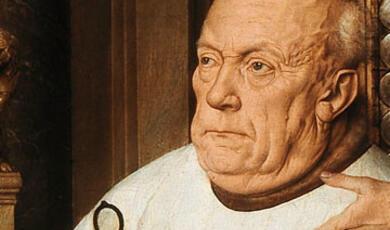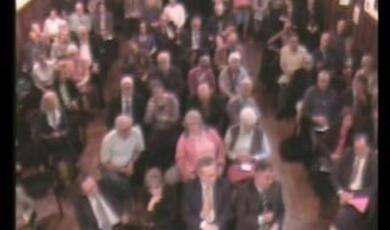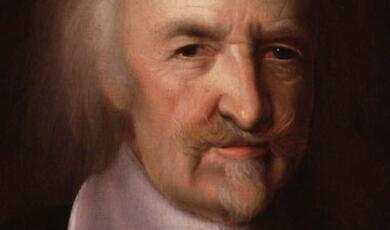Architectural Capricci
Share
- Details
- Transcript
- Audio
- Downloads
- Extra Reading
William Palin, Assistant Curator, Sir John Soane's Museum
An exploration of the long and fascinating tradition of depictions of fantasy views of buildings.
Next lecture in the series was The face of Charles Dickens - portraits of the great author
Download Transcript
Architectural Capricci
By William Palin
SLIDE - GANDY - GREAT TEMPLE
‘Architecture, is enrapt in a cloud of darkness …To unveil its power in true splendour ought to be the aim of the artist’. These are the words of Joseph Michael Gandy perhaps the greatest architectural artist this country has every produced. Although he is still too little known, many of you will have admired his remarkable watercolours at Sir John Soane’s Museum.
SLIDE - GANDY - GREAT TEMPLE - DETAIL
Indeed, it was these beguiling and beautiful works that first set me thinking seriously about architectural fantasy in art. This lecture is the result of these meditations - a foray, if you like, into this rich and compelling subject.
SLIDE - RUINS
Our journey will take us into strange worlds of the fevered imagination, past dark ruins
SLIDE - THE IDEAL CITY
across the deserted piazzas of unbuildable cities;
SLIDE - BOSCH
through the terrifying landscapes of the religious allegorist;
SLIDE - COCKERELL
over the mad assemblages of the architect-teacher,
SLIDE - LAUBIN
and into the celebratory compendia of the building connoisseur..
As you can see from these few examples, architectural visions in art spring from many sources and contain various meanings. They can embody dreams and ambitions or signify folly and vanity. They can be allegorical, educational, comical, theatrical or any of these things together. What unites them, however, is the way in which they harness the emotional power of the architectural form. (1.45)
SLIDE - PANINI
To be strictly accurate the term capricci - as used in the title of this talk - only covers a particular genre in the wider tradition of architectural renderings in art. The term Capricci came into use in the 18th-century to describe the fantasy assemblages of classical antiquity by artists such as Piranesi and Panini. In this type of view accurate representations of ancient buildings are arranged capriciously to make a pleasing medley rather than a record of fact.
SLIDE - PIRANESI
Piranesi, the supreme exponent of topographical engraving, was particularly adept at such visionary compositions. This plate, the frontispiece of Le Antichita Romane (1756), shows the astonishing fertility of his imagination.
SLIDE - PIRANESI - ARCHITECTURAL FANTASY
One of the Soane Museum ’s great treasures is this virtuoso drawing Piranesi made for Robert Adam when he visited the Italian master in Rome in the 1760s. It reveals a looseness and freedom that must have astounded the young Scottish architect who had been trained in the tight controlled drawing style that was the academic tradition of the time. Adam later wrote home describing Piranesi’s ‘amazing and ingenious fancies [which] are the greatest fund for inspiring and instilling invention in any lover of architecture’.
ROBERT ADAM - DESIGN FOR A PALACE
Piranesi’s work was to prove massively influential on the development of European Neo-Classicism. It taught young architects to respond imaginatively to antiquity and not to rely entirely on measuring and copying existing buildings. Indeed this fantasy ‘Design for a Palace’, made by Robert Adam in Rome reflects the direct and immediate influence of his Italian mentor.
SLIDE - GANDY BUILT WORKS
My interest in capricci began with this remarkable watercolour. It hangs behind the vast moveable planes on the south side of the Picture Room at Sir John Soane’s Museum. The artist is Joseph Michael Gandy and the buildings it shows are by the architect John Soane whose house and collection became a public Museum after his death in 1837. This watercolour, painted in 1815, shows over 100 of the architect’s works to date, arranged as models and drawings in a vast gallery, surmounted by a shallow domed ceiling, one of Soane’s architectural signatures. (5.00)
SLIDE - GANDY BUILT WORKS (DETAIL)
In the foreground is tiny figure seated at a desk. He is surrounded by architectural plans and is clutching a pair of dividers. This is Soane of course, dwarfed, in this startling composition, by the fruits of his own imagination. It is a thrilling image, and although since much emulated it was at the time unique in English architecture. Soane’s friend the critic and collector John Britton commented after he saw the work that it was ‘a very interesting drawing …the idea of bringing together, in an abridged form, the principal features of the various works of a single architect, is both ingenious and fascinating.’
SLIDE - GANDY BUILT WORKS
Soane was both an architect and collector. He was also a man obsessed with his own legacy. This image is an attempt to assert his professional identity, his passion for collecting, and his craving for immortality.
SLIDE - CONNOISSEURS IN A ROOM HUNG WITH PICTURES
This may have been the first time an English architect had employed such a conceit but it follows an established tradition in European art. Here, for example, is the Flemish masterpiece of unknown authorship Connoisseurs in a Room hung with Pictures (1620), showing the artistic treasures of prosperous Antwerp gathered together in a single imaginary space.
SLIDE - ROMA ANTICA
A hundred years later G P Panini was producing his own versions. This is the celebrated capriccio of the treasures of Rome painted in 1755.
Panini, who died in 1765, produced fantasy groupings of the monuments of Roman antiquity which allowed the contemporary viewer to taste something of the grandeur and romance of the real buildings. Such renditions were hugely important in whetting the appetite, shaping the expectations of the grand tourist - and also, of course, in providing an-all-in one souvenir of the greatest attractions to be found in the cradle of civilisation. (7.30)
Now, I may be making a frivolous comparison here but it strikes me that multiple view postcards fulfil some of the same function today.
SLIDE - SOUVENIR POSTCARDS (3)
This is ‘joke’ example showing the delights of London ’s shopping streets.
SLIDE - CANALETTO - The Riva degli Schiavoni, looking west before 1736.
Panini’s capricci emerged from a new tradition of urban landscape painting in Italy, characterised by breathtaking precision and clarity. Piranesi belongs to this movement, and so does Canaletto (1697-1768). Ah-ha, I hear you say, but Canaletto’s views are ‘real’. Well, this is not strictly the case. In this Venetian view which hangs at the Soane Museum, the artist has re-arranged the curve of the Grand Canal, changed the angles of the buildings, and played with the perspective. Canaletto is said to have known ‘exactly how to take a great city to pieces and make a new sense of it’. It is no coincidence that Canaletto, like Piranesi, was trained as a theatrical designer. DISCUSS PERSPECTIVE AND PRODUCING A ‘TRUER THAN LIFE IMAGE’.
SLIDE - BELOTTO
This dramatic view of the demolition of the Kreuzkirche in Dresden (1765) is by Caneletto’s nephew, Belotto (confusingly known as Canaletto when painting outside Italy). RECOUNT STORY ABOUT CITY AUTHORITIES PUTTING THE DEMOLITION CONTRACT OUT TO TENDER.
SLIDE - JAN VAN HEYDEN An Architectural Fantasy (1665-70)
It was in the Netherlands, however, that the cityscape was originated. With painters such a as Jan Van Heyden, producing meticulous architectural landscapes. These views reflected the civic amity and national pride of prosperous Dutch cities such as Amsterdam and Leiden.
SLIDE - CAMPANELLA
Capricious views of architecture can be traced back to antiquity. They can be found in Roman decorative wall painting as early as 11BC - some of the most celebrated examples were discovered at the Villa of Agrippa Postumus at Boscotreacase. The fashion for architectural vignettes, often employing perspective trickery reached its zenith, however, in the 1st century BC. This is a coloured engraving of a mural decoration discovered during excavations on a classical villa in the grounds of the Villa Negroni in Rome in 1765. The discovery caused a sensation and parts of the frescoes were purchased by the Bishop of Derry for installation at Downhill house in Ireland.
SLIDE - LIBRARY DINING ROOM
The rich colouring and layering of elements inspired Soane in the creation and decoration of his famous Library Dining Room at his Museum in 1812-13.
SLIDE - CROSS SECTION OF MUSEUM
Indeed, as I will discuss later, the entire Museum, crammed full or ideas, motifs and memories, is a sort of built capricci - a flight of architectural fantasy, with the architecture career, travels and teachings of John Soane distilled into one remarkable composition.
SLIDE - BANK AS A RUIN
Until the Renaissance, European writers and artists perceived the monumental remains of antiquity variously as Pagan excrescences symbolising pride and folly or powerful reminders of the mutability of man’s works. One extraordinary meditation on this theme from these isles survives in an Anglo Saxon poem from the 9th century.
SLIDE - ROTUNDA AS A RUIN
The city buildings fell apart, the works
Of giants crumble. Tumbled are the towers
Ruined the roofs, and broken the barred gate,
Frost in the plaster, all the ceilings gape,
Torn and collapsed and eaten up by age.
Resolute masons, skilled in rounded building
Wondrously linked the framework with iron bonds.
The public halls were bright, with lofty gables,
Bath-houses many; great the cheerful noise,
And many mead-halls filled with human pleasures.
Till mighty fate brought change upon it all.
Slaughter was widespread, pestilence was rife,
And death took all those valiant men away.
The martial halls became deserted places,
The cities crumbled, its repairers fell,
Its armies to the earth. And so these halls
Are empty, and this red curved roof now sheds
Its tiles.
(13)
SLIDE - GOOD GOVERNMENT IN THE CITY (1338-40) DETAIL OF FRESCO IN THE PALAZZO PUBBLICO, SIENA, ITALY BY AMBROGIO LORENZETTI
With the birth of the Renaissance, the idea of the city, and of architecture in general, began once again to assume an important position in the imaginations of artists. This fresco from the Palazzo Pubblico in Siena, entitled Good Government in the City was painted by Ambrogio Lorenzetti in the 1330s. It shows the ideal of the harmonious, prosperous Renaissance city, operating smoothly on every level, its civic, mercantile and religious health clear for all to see. And the backdrop, an impressive cityscape - the fine architecture a physical manifestation this prosperity and security.
SLIDE - THE IDEAL CITY (x3)
A century later in three famous painted panels commissioned by Federico de Montefeltro the Duke of Urbino, the urban landscape came to the fore. One of these one still hangs in the Ducal Palace, one is at the Walter’s Art Gallery in Baltimore and one is in Berlin. Montefeltro was one of new generation of patrons tutored by humanists such as Leon Batitista Alberti. Alberti born in 1404 was the first great theorist of humanist ideals and had a particular interest in architecture, writing his own treatise in 10 books based on the only surviving architectural text from antiquity Vitruvius. The ideas proposed by Alberti and other humanist scholars are reflected in these ideal cityscapes populated by noble structures based on Roman ideals. They were painted, perhaps, to keep such visions of an architecture of humanism lastingly before the eyes of concerned contemporaries. (15)
SLIDE - BOTTICELLI The Adoration of the Kings (1473-4)
Humanistic study heralded not only a new interest but also a new accuracy in the depiction of architecture in Renaissance art. Here, Botticelli’s Adoration of the Kings, takes place among the ruins of a classical temple, signifying the supplanting of pagan religion by the Christian church.
SLIDE - BOTTICELLI The Miracles of San Zenobius (1500)
And the Miracles of San Zenobius are performed before a meticulously rendered backdrop of the Renaissance city, the artist clearly taking delight over the rendering of the architectural elements and the delineation of the perspective views.
SLIDE - CRIVELLI The Annunciation with Saint Emidius (1494)
In Crivelli’s masterpiece, The Annunciation with Saint Emidius, the perspectival construction of the architectural setting, together with the gloriously rendered and embellished classical structures reflect a deep pride in the urban landscape, and a raising of architecture almost to a celestial plane.
SLIDE - PIERO DE COSIMO - The Building of a Palace (c.1515-1520)
The actual building process is celebrated in this idealised view of the construction of a great palace. The painting, from 1520, is by Piero de Cosimo.
SLIDE - JAN BRUEGHEL THE ELDER
Contrast this with Jan Brueghel the Elder’s Adoration of the Kings. Here the protestant tradition has moved towards a perceived reality of setting far from the classical ideals of Botticelli and Crevilli.
SLIDE - JOACHIM PATENIER (1524)
Joachim Patenier blends fantasy landscape with simple, un-idealised architecture highlighting St Jerome ’s isolation.
SLIDE - BOSCH GARDEN OF EARTHLY DELIGHTS
Earlier in the 16th century, painters such as Hieronymous Bosch and Pieter Brueghel also produced architectural landscapes as meditations on Biblical or moral themes. The coded moral and religious messages contained in Bosch’s strange worlds are mostly indecipherable to the modern observer. We are left merely to marvel at his imagination. In his triptych The Garden of Earthly Delights, architecture is displaced by strange vegetable and natural forms - the stuff of science fiction.
SLIDE - PIETER BRUEGHEL
In Pieter Brueghel’s Tower of Babel, however, the story is clear. What is interesting about this painting is that it is the huge doomed tower, rather than the quarrels and chaos surrounding its construction that appears to absorb the painters energies. It is a painstaking architectural rendition and must surely have been drawn from long observation and study of real building.
SLIDE - DE VRIES - KING SOLOMON AND THE QUEEN OF SHEBA ( Pushkin Museum, Moscow )
When the Italian Renaissance eventually reached northern Europe in the 16th century, there was one home-grown artist-painter-engraver whose influence was to be profound. Very little is known about Jan (or Hans) Vredeman de Vries. He trained as a painter but also turned his skills to architectural engraving. His work reflects the artistic cross-currents of the time mixing northern and southern elements - Gothic, Renaissance, Baroque and Mannerism are represented in powerful combination.
SLIDE - DE VRIES - ENGRAVINGS
He produced dozens of publications on architectural topics. These images are from his last and greatest work Perspective published in Leiden in 1604-5. His engravings opened new avenues of architectural invention and representation and his books been described as ‘fantasies and text-books, dreams and pattern-books for apprentices, avant-garde messages and popular pictures’.
SLIDE - CLAUDE - Seaport with the Embarkation of the Queen of Sheba(1648)
50 years later the French classicists Poussin and Claude Lorrain were painting the Roman landscape through the lens of antiquity. Here inSeaport with the Embarkation of the Queen of Sheba of 1648 Claude brings noble antique and modern building types together to a create biblical setting of epic character before flooding the scene with brilliant Mediterranean sunlight.
SLIDE - GANDY
So we’ve looked at some of the predecessors to the Gandy painting that so captivated me at the Soane Museum, but what of the successors.
SLIDE - THOMAS COLE - The Course of Empire: Destruction 1836
This is the penultimate painting in a series of five, by Thomas Cole following the rise and fall of a classically inspired civilisation. The other paintings are: The Savage State, The Pastoral State, Consummation and Desolation. Cole was born in Bolton, Lancashire but emigrated to America at the age of 18 becoming the most important American landscape painter of his generation. Visits to the galleries of Europe in 1831-2 filled his head with lofty and Romantic themes reflected in the epic scope of this series and his other great work ‘The Voyage of Life’. Cole’s works also echo the prevailing currents of the Romantic movement and its fascination with the rise and fall of nations and the destruction of tyranny. Themes echoee in Shelley’s celebrated Sonnet Ozymandias.
I met a traveller from an antique land,
Who said -- "two vast and trunkless legs of stone
Stand in the desert... near them, on the sand,
Half sunk a shattered visage lies, whose frown,
And wrinkled lips, and sneer of cold command,
Tell that its sculptor well those passions read
Which yet survive, stamped on these lifeless things,
The hand that mocked them, and the heart that fed;
And on the pedestal these words appear:
My name is Ozymandias, King of Kings,
Look on my Works ye Mighty, and despair!
Nothing beside remains. Round the decay
Of that colossal Wreck, boundless and bare
The lone and level sands stretch far away
SLIDE - C R COCKERELL - The Professor’s Dream
I think it is fair to say that architects at that time were generally more concerned with reconstruction than destruction. In this Gandy inspired hypnotic vision of 1818, the English architect and Royal Academician C R Cockerell assembles 4000 years of architectural history within the shadow of the Pyramids at Giza. Cockerell was Professor of architecture from 1839-59 and this image is most likely a visual counterpart to his unpublished lectures. Cockerell, like Soane held a deep conviction that an intelligent study of the past was the only certain path to creativity in the present.
SLIDE - SCHINKEL
In Prussia the prodigiously talented Karl Friedrich Schinkel (1781-1841) was busy rebuilding Berlin as one of the great Neo-classical cities of Europe. Schinkel also painted and this mesmerising work ‘View in the Prime of the Hellenic Epoch’ reflects a fascination in and deep admiration for the miraculous builders of antiquity and a period where art was at its zenith.
SLIDE - ISRAEL IN EGYPT by Sir Edward John Poynter (1836-1919)
In the 1860s Sir Edward Poynter recreated Egypt on a grand scale in this painting which hangs in the Guildhall Art Gallery. Poynter like Schinkel would have drawn on the growing body of archaeological information available at the time. 100 years before Egypt had been the least understood of the ancient civilisations.
SLIDE - KETTELHUT - METROPOLIS
Fritz Lang’s ‘Metropolis’ 1927 remains the seminal cinematic vision of the city of the future. Lang’s architectural muse was New York, and he described his emotions when seeing the city for the first time from a ship near Ellis Island :
‘The buildings seemed to be a vertical veil, shimmering, almost weightless, a luxurious cloth hung from the dark sky to dazzle, distract, and hypnotise. At night the city did not give the impression of being alive; it lived as illusions lived. I knew then I had to make a film about all of these sensations’
Lang communicated his vision to Erich Kettelhut who produced the set designs for the film, of which this is one.
SLIDE - DE CHIRICO (1888-1978) - THE ENIGMA OF A DAY (1914)
Another troubling urban landscape is shown in this hugely influential painting by Paolo de Chirico. De Chirico’s images of the ‘dream city’ were admired by Magritte, Dali and Delvaux and was to become a favourite subject of the surrealists. Here de Chirico arranges half-remembered architectural forms in a virtually deserted landscape. It’s effect is curious, like a postcard from somewhere we all vaguely remember having visited, long ago.
SLIDE - ALGERNON NEWTON (x2)
In 20th-century British art the tradition of architectural fantasy was continued in some surprising and beautiful ways. Algernon Newton’s haunting north London street scenes have a strange power. Devoid of human beings they assume the same surreal quality of the ideal cities of Urbino. Newton proves, I think, that even the most ordinary, the most mundane architectural scene can trigger deep emotions.
SLIDE - THE CHURCH IN RUTLAND WATER - FELIX KELLY (1916-1994)
Felix Kelly achieves the same elegiac power by combining a sense of permanence and decay, of safety and of threat. Here is Normanton church, Rutland water. Saved from the man-made reservoir by being raised on stone piers.
SLIDE - WHISTLER MURALS AT PLAS NEWYDD, ANGLESEY (x2)
More conventional capricci were produced by Rex Whistler whose murals at Plas Newydd in Anglesey are perhaps the most famous of his architectural compositions.
SLIDE - CARL LAUBIN Hawskmoor (2000)
And most recently, Carl Laubin’s capricci have shown the tradition to be as strong and as popular as ever. Laubin is perhaps the most worthy successor to Gandy. This painting is a homage to the great English baroque architect Nicholas Hawksmoor - including both his built and unbuilt works.
Hawksmoor’s buildings have long exerted a strong influence over the imaginations of artists, novelists and poets and his work has been frequently included in imaginative compositions. The churches, in particular, have always provoked strong reactions. Writing in the 1960s Ian Nairn talked of one church, St George-in-the-East, as representing the ‘more than real world of the drug addict’s dream’; John Summerson architectural historian and one time Curator of Sir John Soane’s Museum was affected by their ‘gloomy grandeur that approaches the monstrous’; and Kerry Downes who has written the seminal text on the architect talks of Hawksmoor’s ability, through these churches, to ‘fascinate the eye and disturb the memory’.
Hawksmoor’s architectural imagination drew from a detailed knowledge of architectural history - his obituarist notes he was ‘skill’d in the History of Architecture, and could give an exact account of all the famous Buildings, both Antient and Modern, in every Part of the World; to which his excellent Memory, that never fail’d him to the very last, greatly contributed’.
The shocking contrast between the beautiful visions of his architectural imagination and the reality of post-fire London caused him much frustration. He wrote ‘When London Burnt in 1666, out of that fatall accidentall mishchief one might have expected som good when ye Phoenix was to rise again …convenient regular well built Citty …but instead of these, we have nor City, nor Streets, nor Houses, but a Chaos of Dirty Rotten Sheds, always Tumbling or takeing fire, with winding Crooked passages …Lakes of Mud and Rills of Stinking Mire Running through them …they [the Government] ought for ye Publick good to have Guided it into a Regular and commodious form, and not have suffered it to Run into an ugly inconvenient self destroying unwieldy Monster …’
SLIDE - GANDY ARCHITECTURAL DREAMS
And this, I think is a good point to return to Soane with Gandy’s companion piece to Soane’s Built works. This watercolour, produced 3 years-later in 1818 is entitled ‘Architectural Visions of Early Fancy in the Gay Morning of Youth and Dreams in the Evening of Life’.
SLIDE - GANDY ARCHITECTURAL VISIONS (DETAIL)
It is a melancholy mix of the Neoclassical dreams of Soane’s student years and early career, together with later professional disappointments, the contemplative mood deepened by the inclusion of the funeral procession of Nelson, winding its way up the hill to the left.
This powerful work is a meditation the frustrated ambitions of the architect. There is no other profession in which the process of turning a conceived idea into reality is so enormously difficult. And so, like all fantasy, the paper designs provide an outlet, an escape from the disappointments that spring from un-fulfilled ambitions.
Soane’s own views on the lost opportunities for rebuilding London were not dissimilar to Gandy’s:
Why not erect a triumphal arch to make an entrance onto Hanover Square from Oxford Street, and another at Hyde Park corner? See the French entrances to Paris. Would to God some of the entrances to this mighty metropolis were decorated with avenues of trees, with monuments and the whole terminated with magnificent triumphal arches, instead of these miserable lanes of human habitations, for they do not deserve the name of houses, or rather of high brick wall with holes perforated for light and for egress and regress.
SLIDE - THE DOME AREA
Late in his life, with many of his architectural visions unrealised, Soane poured his emotions increasingly into his Museum on Lincoln’s Inn Fields, creating a built capricci crammed full of architectural ideas and literally brimming with casts, fragments, and other examples of the art. The Museum is a compendia, and encyclopaedic construction inspired by the memories of Soane’s time in Rome and the prints and paintings of Piranesi, Robert, Panini and others.
SLIDE - PASTICCIO
He even creates a capricci-inspired architectural folly. A column of fragments telling the story of architecture.
SLIDE - THE LITTLE STUDY
Each room exhibits a different Soanean spatial effect, a use of light
GANDY - DOME AREA AT NIGHT
and, at times it is as if he is striving to match the picturesque and poetic renderings of his artist Gandy.
SLIDE - THE MODEL ROOM
And the model room, hidden away on the 2nd floor of the house, resembles a realised version of the famous Gandy watercolour.
SLIDE - BUILT WORKS
So, in many ways, the Museum represents a sort of culmination in the tradition of architectural fantasy. It is a celebration of the power and fascination of the architectural form. A tradition that we have traced back to the mural painters of ancient Rome through the Renaissance, through the artists of the Grand Tour, through Neoclassical dreamers, to the surrealists and beyond. I hope that I have dispersed at least some of that dark cloud which Gandy claimed to have ‘enrapt’ architecture and revealed a few of the many beautiful examples of the enigmatic architectural fantasy.
© William Palin, Gresham College, 17 November 2005
This event was on Thu, 17 Nov 2005
Support Gresham
Gresham College has offered an outstanding education to the public free of charge for over 400 years. Today, Gresham plays an important role in fostering a love of learning and a greater understanding of ourselves and the world around us. Your donation will help to widen our reach and to broaden our audience, allowing more people to benefit from a high-quality education from some of the brightest minds.


 Login
Login







